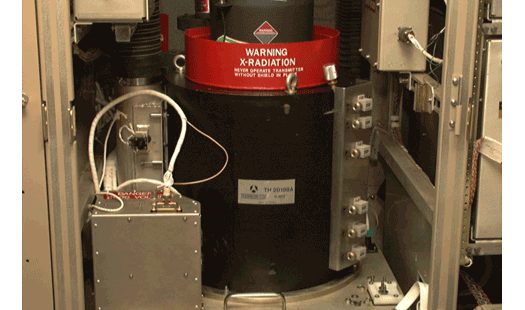The heart of the transmitter section is a tube that produces microwave power at the radio frequency (RF) for which it is designed. Two kinds of transmitter tubes are in general use in radar systems today: "magnetrons" and "klystrons". The magnetron is an oscillator tube in which the frequency of the RF oscillations is determined mainly by the internal structure. The klystron is usually operated as a power amplifier, the microwave frequency being established by a stable low-power RF oscillator that feeds into it.
WSR-88D Klystron
The choice between the two kinds of transmitter tubes is governed by the application of the radar system. Transmitters using magnetrons are smaller than klystron based transmitters of comparable power output. They are therefore likely to be preferred where small size is important, as in airborne and other mobile uses. A klystron transmitter produces a more stable output frequency than a magnetron and is capable of delivering greater average power. Frequency stability is important when frequency and/or phase measurements are to be made on the echoes, as in Doppler radar systems, and klystron transmitters are more desirable for this application.
The operation of the radar system is controlled by a timer or synchronizer contained in the transmitter section (Figure 3). It generates a series of timing pulses (also called "trigger" or "sync" pulses) at a rate that establishes the pulse repetition frequency (PRF) of the radar. Each pulse triggers the modulator, activates the automatic frequency control (AFC) circuit, and causes the display circuits to be reset to their starting condition.
The modulator contains an energy-storing device which accumulates energy during the interval between transmitted pulses. When the modulator is triggered by a timing pulse, it delivers the stored energy to the transmitter tube in a short pulse of high voltage and high power. The energy-storing device is usually a "pulse-forming network" that not only stores the energy but also determines the shape of the pulse delivered to the transmitter tube. In radars with magnetron transmitters, the shape of the modulator pulse determines the shape of the transmitted pulse, but in some klystron transmitters its shape is established instead by a pulse developed in an intermediate power amplifier (usually a small klystron) located between the master oscillator and the output klystron.
